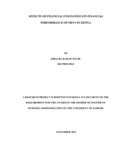| dc.description.abstract | Diversification provides a stable and less volatile income, economies of scope and scale, and the ability to leverage managerial efficiency across products. As a result of financial innovation, the economies of scale and scope caused through the joint production of financial activities led to increased efficiency of Financial Institutions. Many studies have done on financial performance of microfinance institutions, but none of them have focused on effects of financial innovation on their financial performance. The objective of this study is to determine effects of financial innovation on financial performance of Microfinance Institutions. A descriptive research design was adopted for the purposes of this study. The study was based on 12 registered and licensed DTMFIs in Kenya. The researcher gathered a 7-year (2008-2014) secondary data from the Association of Microfinance Institutions (AMFI), Central Bank of Kenya (CBK) and published newspapers (interest income and non-interest income), and the DTMFIs‘ websites (A ratio of revenue from new ideas divided by the cost incurred in implementing the new ideas).The study focused on dependent and independent relationship, and a multiple regression analysis was conducted to determine the relationship of three dependent variables, which included interest income, noninterest income, and a ratio of revenue from new ideas divided by the cost incurred in implementing the new ideas; and dependent variable, which is financial performance (measured by ROE). The regression analysis established that the three independent variables have a positive correlation with the dependent variable. Interest income, noninterest income, and a ratio of revenue from new ideas divided by the cost incurred in implementing the new ideas were found to have positive influence on financial performance. The ANOVA analysis was meant to determine whether the variation in the independent variables explains the observed variance in the outcome, that is, financial performance, as used in the study. ANOVA findings in this study revealed that there was correlation between the predictor variables interest income, noninterest income, and a ratio of revenue from new ideas divided by the cost incurred in implementing the new ideas and response variable (financial performance) since P- value of 0.040 is less than 0.05, which is an indication of a positive relationship between the variables used in this study. | en_US |



